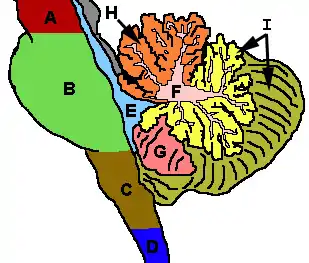| CANVAS | |
|---|---|
 | |
| Cerebellum and brainstem | |
| Specialty | Neurology |
| Symptoms | Difficulty walking. Poor coordination. Decreased sensation. Chronic cough. Dysphagia. |
| Usual onset | 40–60 years old |
| Duration | Long term |
| Causes | Genetic (inherited or new mutation) |
| Diagnostic method | The diagnosis is clinical whereby there is a sensory neuropathy with cerebellar dysfunction, or a sensory neuropathy with a family history of similar signs and symptoms. If there is clinical suspicion, then RFC1 genetic testing should be performed. |
| Prevention | Genetic counselling |
| Treatment | There is no treatment therefore supportive care is the mainstay of management. Genetic counselling should be provided before the gene is tested for however and the implications this may have on family planning. |
| Medication | Not available |
| Frequency | Unknown |
Cerebellar Ataxia with Neuropathy and Vestibular Areflexia Syndrome (CANVAS) is an autosomal recessive late-onset heredodegenerative multisystem neurological disease. The symptoms include poor balance and difficulty walking. Chronic cough and difficulty swallowing may also be present. Clinical findings include ataxia, sensory neuropathy, and absence of the vestibulo–ocular reflex. The syndrome was initially described in 2004.[1] In 2019, the cause was identified as biallelic pentanucleotide expansion in the RFC1 gene. [2] [3]
Signs and symptoms
Diagnosis
Treatment
Specific treatment is lacking. A multidisciplinary approach to supportive care is recommended.
Prognosis
The progression is typically slow, with 55% of patients needing mobility aids 10 years after onset, and 25% needing a wheelchair after 15 years.[4]
Epidemiology
The prevalence of the disease is currently unknown, largely owing to its recent description and delineation from other forms of autosomal recessive cerebellar ataxia.
References
- ↑ Migliaccio, Americo A.; Halmagyi, G. Michael; McGarvie, Leigh A.; Cremer, Phillip D. (2004-02-01). "Cerebellar ataxia with bilateral vestibulopathy: description of a syndrome and its characteristic clinical sign". Brain: A Journal of Neurology. 127 (Pt 2): 280–293. doi:10.1093/brain/awh030. ISSN 0006-8950. PMID 14607788.
- ↑ Houlden, Andrea; Simone, Roberto; Sullivan, Roisin; Vandrovcova, Jana; Tariq, Huma; Yau, Wai Yan; Humphrey, Jack; Jaunmuktane, Zane; Sivakumar, Prasanth; Polke, James; Ilyas, Muhammad (2019-03-29). "Biallelic expansion of an intronic repeat in RFC1 is a common cause of late-onset ataxia". Nature Genetics. 51 (4): 649–658. doi:10.1038/s41588-019-0372-4. ISSN 1546-1718. PMC 6709527. PMID 30926972.
- ↑ Benkirane, Vincent; Da Cunha, Isidor; Koenig, Marelli; Tuffery-Giraud, Larrieu; Cossée (2022-07-27). "RFC1 nonsense and frameshift variants cause CANVAS: clues for an unsolved pathophysiology". Brain. doi:10.1093/brain/awac280. PMID 35883251.
- ↑ Cortese, Andrea; Tozza, Stefano; Yau, Wai Yan; Rossi, Salvatore; Beecroft, Sarah J; Jaunmuktane, Zane; Dyer, Zoe; Ravenscroft, Gianina; Lamont, Phillipa J; Mossman, Stuart; Chancellor, Andrew (2020-02-10). "Cerebellar ataxia, neuropathy, vestibular areflexia syndrome due to RFC1 repeat expansion". Brain. 143 (2): 480–490. doi:10.1093/brain/awz418. ISSN 0006-8950. PMC 7009469. PMID 32040566.